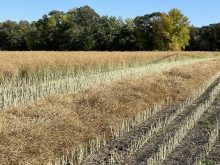Derek Bunkowsky, chief grain inspector for Canada, is committed to fulfilling his statutory duties.
After all, it’s his signature that is on the Canadian Grain Commission’s (CGC) Certificate Final guaranteeing the grade of every bulk export of Canadian grain leaving the country by ship.
“I take that very seriously,” Bunkowsky said in an interview Dec. 7, 2021. “I have a lot of pride in that and making sure that those certificates are accurate.
“I can’t stress enough how important that is in providing customers of Canadian grain those assurances and that’s my responsibility and I don’t take that responsibility lightly.
Read Also

Cooking cabbage deserves revival
Cabbage recipes don’t need to be boring. Rediscover the taste, diverse uses and local Prairie food traditions of this leafy green
“Sometimes we run into an issue with cargo not meeting spec (specifications) when it’s going onto a vessel. I get involved with that and I make the final call.”
Certificate Finals, the CGC’s grain-grading system, Canada’s variety registration system, and the CGC itself established by the Canadian government in 1912, are all part of Canada’s long-standing co-ordinated effort to ensure Canadian grain quality.
Bunkowsky, who grew up on a farm southeast of Brunkild, in the province’s pancake-flat, fertile Red River Valley, was appointed chief grain inspector this past June, achieving a goal he set years ago.
“Shortly after I started as an assistant grain inspector at the CGC, and I saw how things worked, I said to myself, ‘someday I would really like the opportunity to be the chief.’
“It took a lot of hard work and determination to get there.”
Years of CGC grain-inspecting experience no doubt helped, but Bunkowsky, who also farmed and worked for several grain companies, believes that experiences make him well suited for the role.
“I have gained lots of experience doing all three of those things and I think they have given me a broad understanding and appreciation for the different challenges facing producers, handlers and regulators,” he said.
After graduating with a diploma in agriculture from the University of Manitoba in 1994 Bunkowsky started working at United Grain Growers’ (UGG) elevator at Fannystelle, as a sales agronomist.
A short time later he started buying grain for UGG at its Brunkild elevator.
Manitoba Pool Elevators had a facility there too — one, ironically, that his family “patronized religiously” as he was growing up.
In 1997 Bunkowsky moved a few miles west to initially do agronomy and crop input sales for Richardson International at its Mollard high-throughput elevator. Two years later he was buying and shipping grain there.
Much of Mollard’s wheat was exported to the United States and Mexico. Bunkowsky developed a rapport with some of the CGC inspectors working there to inspect cargoes. In 2001 he had the opportunity to accept a job offer from the CGC to become a CGC grain inspector.
By then Bunkowsky, in addition to working full time at the elevator, was also farming. The busiest time at the elevator was harvest, which was also when he needed to be taking his family’s and his own crop off. The grain commission was more flexible, allowing him to take holidays when he needed to farm.
While he didn’t plant his first crop until 1996, Bunkowsky had long been involved with his family’s operation.
“I always wanted to be in the field with my dad and my grandpa from a very, very young age,” he said. “I started driving combines when I was 12 years old on my own and just helping out wherever I could on the farm from a very young age.”
In 2012 Bunkowsky joined Cargill as a senior grain inspector but rejoined the CGC two years later as an inspection specialist, and eventually becoming an inspection program manager in 2017.
Bunkowsky is thankful to his family for teaching him how to farm, to the grain companies where he learned about the grain business and the CGC for career advancement opportunities.
“They all gave me opportunities to develop to where I am now,” he said. “I am really thankful for those opportunities and all of the relationships that I have built with many producers and handlers industry-wide. Those relationships are important to me and I want to continue to foster and develop them in the future.”
As a farmer and grain buyer Bunkowsky learned a lot about the grain industry and inspecting grain, but it wasn’t until joining the CGC that he was exposed to the CGC’s Grain Research Laboratory (GRL) and its scientific work to ensure Canadian grain quality.
Some of it includes assessing new varieties of milling wheat to ensure milling and baking performance meets the standard for the intended class. That’s key to making Canada’s grading system work, much of which is based on how a grain sample looks.
“When we (CGC) assign, say, a new variety to the CWRS (Canada Western Red Spring wheat) class, it’s not just visual,” Bunkowsky said. “There’s a whole bunch of work that goes on at the grain research lab to ensure that protein levels are going to be there, to ensure gluten levels are going to be there, to ensure that extensibility and dough-mixing properties are going to be there.”
As a result so long as the wheat is visually sound, it will in most cases meet class specifications.
That means increased system efficiency. Grain buyers, most times, can quickly grade wheat as it’s delivered, reducing the need to test every load for end-use performance.
Assessing dockage (weed and other seeds) is part of the grading process.
Protein levels and moisture content are measured with instruments.
“Our visual grading system has been around for a long time and there has been some scrutiny to it, but I can tell you that our visual grading system has done an extremely good job of ensuring quality, including end-use functionality traits that millers and bakers are looking for,” Bunkowsky said. “We know that our (visual) severe sprouted tolerances are a very good indicator of what the falling number is going to be in wheat. By doing that visually we don’t need to be running falling number tests on every delivery, which honestly isn’t necessary as it adds costs and reduces efficiencies for the industry.”
Customers are well served and recognize Canadian milling wheat for its high quality and cleanliness, he added.
But as good as the grading system is it’s not static, Bunkowsky said.
“As things evolve we’re going to look at new technologies that perhaps can increase the efficiency and accuracy of grading grain,” he said. “But let me tell you we have a very good system in place.
“Any changes to grade standards and testing methodologies would have to be recommended by the grains standards committee (which represents the grain industry). The CGC works closely with stakeholders — producers, handlers, processors — across the value chain. We don’t make changes lightly without collaborating and having recommendations from the industry as a whole.”
The GRL’s work since 2015 into the impact of visual mildew and frost damage on milling wheat resulted in higher tolerances for both, Bunkowsky said.
“We’ve made some significant changes to our physical standard samples to reflect that work… which has benefited producers and handlers because there has been more grain grading in the top grades to be exported, which adds value to the whole industry,” he said. “And it’s backed by science.”
Another role performed by the chief grain inspector for Canada is settling grading disputes between farmers and grain buyers referred to as ‘subjects to inspector’s grade and dockage.’
“I want to highlight the fact that it is the producer’s right to request that if they want,” he said. “Of course we would hope that producers and handlers can resolve these types of situations amongst themselves, which for the most part they do. I want to make it clear that we’re there to help in that type of situation and because that is part of our mandate under the Canada Grain Act. The real important piece of it is that it’s unbiased. It’s not there to favour the producer. It’s not there to favour that handler. It’s there to give unbiased grading and accurate results so both parties know exactly what they’re dealing with in relation to our grade standards.”
The chief grain inspector for Canada’s ruling is final and can’t be appealed.
While Bunkowsky is the chief grain inspector, he stressed it’s a team effort. As inspectors retire, developing and replacing them is a top priority, he added.
“That inspection work that we do… is the key foundational piece that ultimately allows the CGC to deliver on its mandate,” Bunkowsky said.
“I really feel the Canadian Grain Commission and what we do to ensure quality for our customers around the world, is really important. And I think we do a very good job of that. It gives Canadian grain an advantage to some degree I think. We can provide our customers with those kinds of assurances based on our grading system.”
















